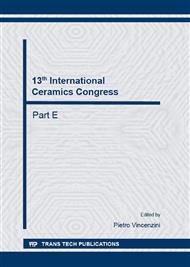p.70
p.79
p.82
p.88
p.94
p.100
p.108
p.117
p.123
Al2O3 Preforms with Gradient Porosity for Brake Disk Application
Abstract:
It has been known for many years that the incorporation of metallic particulates into a ceramic matrix can bring about the improvement of the mechanical properties of ceramics. Alumina/copper composites are well-known for their good frictional wear resistance, high resistance to thermal fatigue, high thermal conductivity as well as high absorption and dissipation of heat. The combination of the properties offered by alumina-copper composites makes them particularly interesting for wear applications in both automobile and aerospace industries. In the present paper we report on the design and production of a new class of alumina-copper functionally graded materials (FGM) which have technological potential for application in automotive brake disks. More specifically, this work deals with the development of the interpenetrating network structure of the FGM material. The manufacturing procedure was based on the gas-pressure infiltration of graded porous alumina preforms by liquid copper. The graded porous ceramic preforms with porosity ranging between 20 and 60% were made by casting foils made from slurries, the main components of which were alumina powder and rice starch powder (a pore forming agent), laminating these foils, subsequently burning-out the starch and last but not least performing a sintering process. A fundamental part of the presented investigations was to correlate the grain size of the alumina powders (Almatis, HVA FG and CT 1200 SG) and the pore size distribution, microstructure and selected mechanical and thermal properties of the porous ceramic preforms.
Info:
Periodical:
Pages:
94-99
Citation:
Online since:
October 2014
Price:
Сopyright:
© 2014 Trans Tech Publications Ltd. All Rights Reserved
Share:
Citation:


